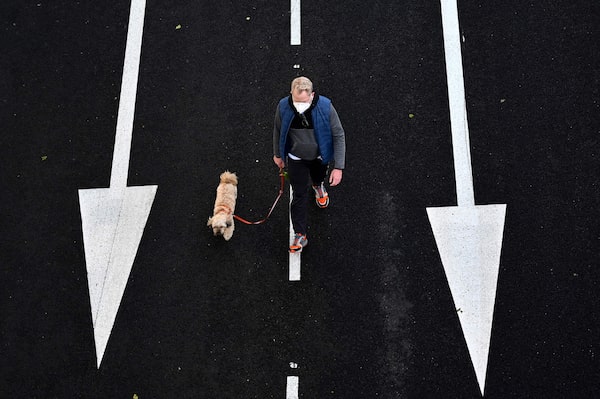
A man wearing a mask walks his dog in Madrid on May 10, 2020, during the hours allowed by the government to exercise, during the national lockdown to prevent the spread of COVID-19.GABRIEL BOUYS/AFP/Getty Images
Build your reading list with our weekly Books newsletter. Sign up today.
Norwegian writer Torbjorn Ekelund’s new book is called In Praise of Paths, but in it he returns several times to our habit of carving our own route.
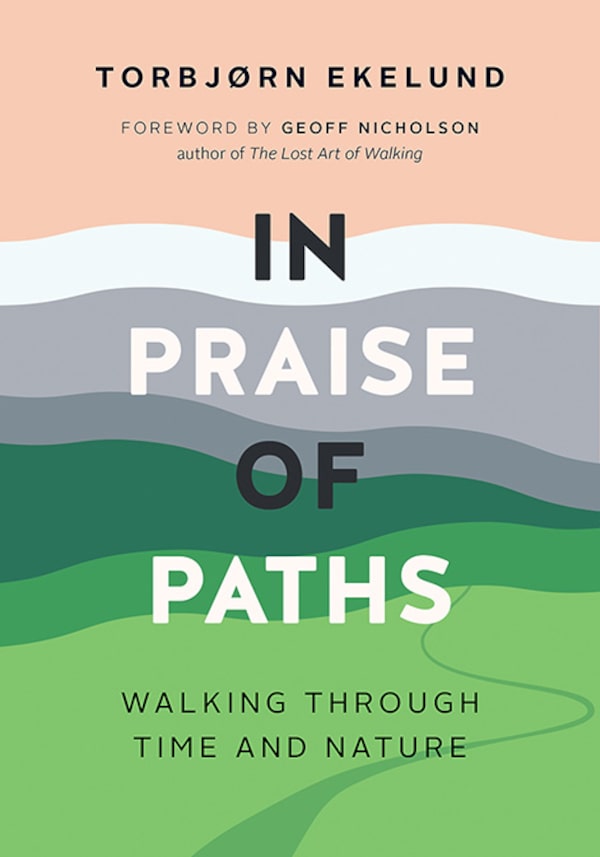
Handout
Pedestrians in Oslo leaving marks in the snow as evidence of how they cut a corner. Young people meandering this way and that. If everyone walked like a child, Ekelund believes, “two pairs of feet would never touch the same spot.”
“People will always choose their own paths,” he writes in the book, which came out in May. “They will protest if faced with unreasonable restrictions. It’s impossible to tame us – any dictator or kindergarten teacher knows this.”
While a visitor not familiar with cities might view the crowds of people moving along a sidewalk as an automaton mass, the actual experience is closer to a slightly anarchic dance. During the COVID-19 pandemic, though, our desire to go our own way has laid bare how constrained pedestrians really are.
Even as moving on foot emerged as one of the safest and easiest ways to get around, take exercise or clear one’s head, calls rose for restrictions such as one-way sidewalks. Some cities opened up new spaces for pedestrians, but others lagged, reluctant to let them take over any of the road in spite of record low traffic volumes.
“Maybe when this is all over we can widen the sidewalks,” former television anchor Dan Rather mused on Twitter in early April.
While the lasting impact of the pandemic remains unknowable, many have framed it as a revolutionary moment with potentially major effect on politics, economics, the labour movement and how we live. It could be this for pedestrians, too. How long will it be before people are willing to crowd together on the narrow space allotted them in many cities? Or will they ever again?
Walking wherever you liked wasn’t always a radical act. Before the mass adoption of the motor car, urban streets were a shared space. Those on foot were then pushed to the edges, onto sidewalks that in many cases later got narrowed to expand room for drivers. But pedestrians can be a tough bunch to corral.
“People will always choose where they want to walk,” Ekelund writes. “We take shortcuts across areas where landscape planners don’t want us to walk; it is a quiet form of rebellion against uniformity and conformity.”
Here are four other authors whose work may inspire you to walk assertively.
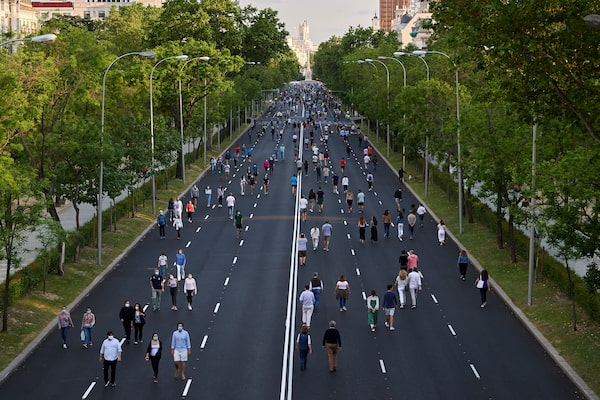
People walk and exercise through Paseo de la Castellana street during the allowed timetable on May 9, 2020 in Madrid, Spain.Carlos Alvarez/Getty Images
Militancy
Walking was fundamental to William Wordsworth’s writing process – he would think and compose as he strode along – and he covered a lot of ground. According to an estimate by contemporary Thomas de Quincey, the Romantic poet walked close to 290,000 kilometres over the course of his life.
It was also sometimes his subject. While best known for his nature poetry, Wordsworth described walking a deserted city in the haunting St. Paul’s. Written in 1808, the poem reads in part:
I parted from thee, Friend, and took my way / Through the great City, pacing with an eye / Downcast, ear sleeping, and feet masterless / That were sufficient guide unto themselves, / And step by step went pensively.
Not just a chronicler of walking, Wordsworth helped launch a generations-long tradition of British rambling and pedestrian stroppiness. And the poet himself was no stranger to asserting his right to walk.
In Wanderlust, Rebecca Solnit describes a memorable scene in which Wordsworth, then 66, was dining at a castle in Cumbria. The local lord complained that a wall on his land had been taken down and vowed to have the man responsible whipped.
“The grave old bard at the end of the table heard the words,” according to Solnit, citing an 1887 letter published, decades after the incident, in The Manchester Guardian. “The fire flashed into his face and rising to his feet, he answered: ‘I broke your wall down, Sir John, it was obstructing an ancient right of way, and I will do it again.’”
Sharing
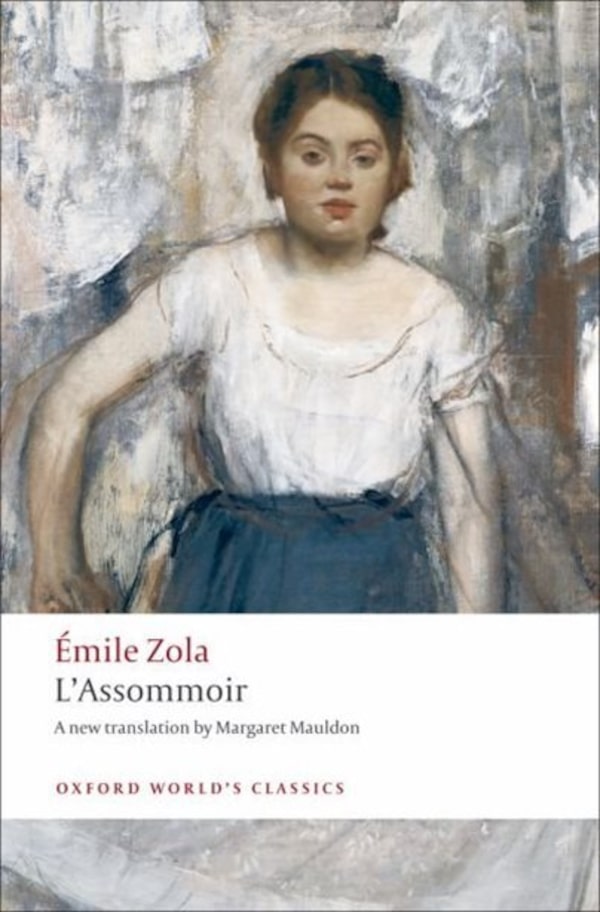
Handout
In the cities of the 19th century there was less debate about where pedestrians were supposed to be walking. Although horse-drawn carriages were ubiquitous in urban centres, the road was understood to be open to everyone.
In l’Assommoir, Émile Zola’s 1876 novel of working-class degradation, walking plays a central role in several key moments.
As Gervaise and Coupeau’s wedding party is killing time between ceremony and reception, they decide to visit the Louvre, walking from northern Paris. These were not dandy flâneurs strolling with a leashed turtle to ensure they moved at a pace suitable for preening and being seen. This was walking as transportation. Their route is described in detail and can be followed today – though you best not spread right across the road the way they did.
More than 300 pages later – after an epic series of misfortune and mistakes – Gervaise is reduced to walking a shabby street, meekly attempting to sell herself. Her route on this day stretches between ruined abattoirs and a hospital, “from the bloody courtyards where beasts were struck down to the dimly lit wards where death stiffened you in a communal shroud.”
This pitiful scene comes on the heels of, and contrasts, a section painting a portrait of industrious blue-collar Parisians and how they used the street. It takes place at the end of the work day, when “ladies with hats and smartly turned-out gentlemen” are swamped as the road fills with the working-class walking home.
“An ever-growing swarm of smocks and linen jackets spread across the roadway,” Zola wrote. “These chaps were whistling, tapping their feet, marching straight ahead, their eyes fixed on supper.”
Seclusion
Jean-Jacques Rousseau’s posthumous Reveries of the Solitary Walker, published in 1782, starts with one of the great opening lines of literature: “So now I am alone in the world.”
By the 1770s, the French philosopher had been shunned for his writing and was disaffected with his contemporaries, leaving him living a form of extreme physical distancing. Writing a century before the urban squalor described by Zola, his preferred approach to philosophizing was to ramble outside the city.
“These hours of solitude and meditation are the only ones in the day when I am completely myself,” he wrote. “When I reach places where there is no trace of men I breathe freely.”
When he penned these words, Rousseau was living in Paris, having renounced his Genevan citizenship. The 10 loosely connected essays were assessments of his life, a conversation with his soul.
But like today’s sidewalk user trying to evade another person, it wasn’t always safe to lose himself in his thoughts. Early one evening, descending from Ménilmontant, now a Paris neighbourhood but then outside the city, he describes being bowled over by an unruly dog.
“Some people walking in front of me suddenly stepped aside and I saw a Great Dane rushing at full tilt towards me, followed by a carriage,” he wrote. "It was nearly night when I regained consciousness.”
Rousseau’s book is an attempt to philosophize with himself, a testament to the richly intellectual life one can have while walking solo.
Recovery
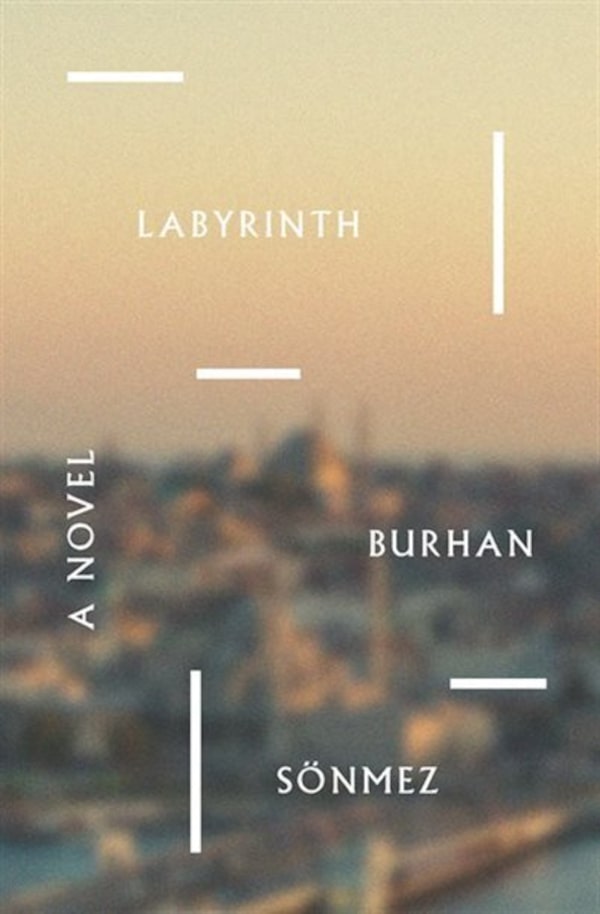
Handout
In the Burhan Sonmez novel Labyrinth, released last year, protagonist Boratin has suffered grievously. He attempts suicide by jumping off the Bosphorus bridge and survives, with one effect being lost memory.
He’s left unclear as to who he is, struggles to navigate crowds and has to rediscover Istanbul.
“I walk slowly, to give me the chance to recognize the street I am on,” Sonmez writes. “It’s a long street. The surface is cobbled. Each stone is followed by another, then another. They stretch as far as the eye can see, like sand dunes in the desert.”
The book predates the pandemic but the protagonist’s desire to avoid close proximity – at one point retreating indoors where he won’t be jostled – foreshadows our current orders not to be within two metres of anyone with whom we don’t live.
“I need to learn how to walk in a crowd all over again,” Boratin thinks.
Will we be willing to do the same?
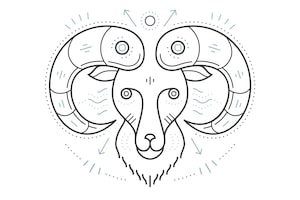



 Oliver Moore
Oliver Moore